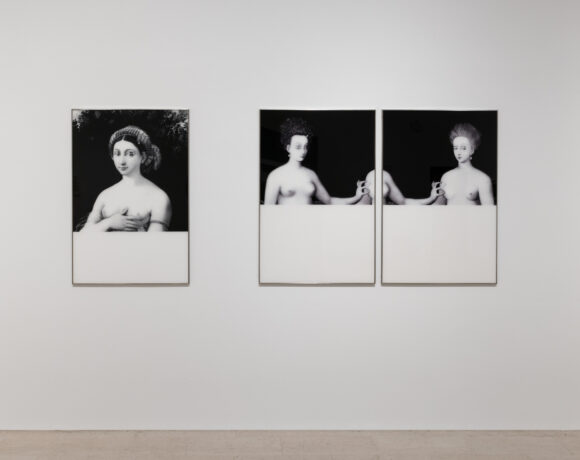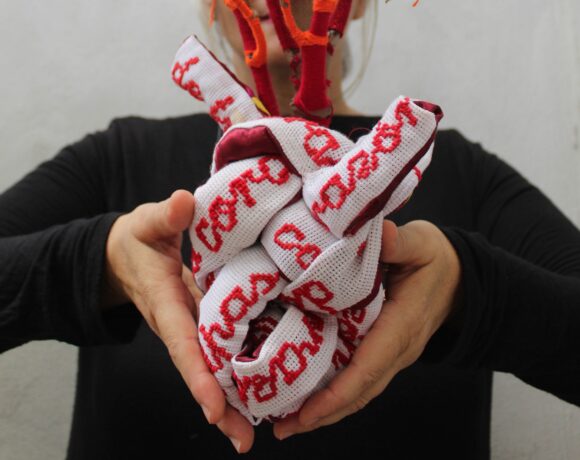In the heart of Milan, Samantha Lina opens – for the first time – the doors of her studio. A multifaceted selection of works recounts her journey as an artist between emotion and creativity. Her art is a silent and meditative dance, an interweaving of matter and meaning that invites the viewer to rediscover the value of the symbolic and feeling. Through a multifaceted language – from painting to sculpture, from collage to video – a restless and enthralling world draws paths that go beyond the visible and give a suspended perception of waiting and movement, stillness and transformation. The exhibition “La danza nel giardino”, set up in the studio, is an intimate look at an artistic journey that eludes definitions and allows itself to be discovered as a revelation. Samantha Lina, who in her universe of symbols and forms speaks an ancient and deeply human language, invites us in this interview to deep listening and authentic involvement, guiding us beyond the boundaries of traditional representation.

Samantha Lina, artist’s studio, photo © Samantha Lina
Francesca Liantonio: An artist’s studio housed in a historic place in Milan, Palazzo delle Stelline. How does it feel?
Samantha Lina: Palazzo delle Stelline has always had a mysterious fascination for me, a subtle link to past stories and hidden memories. There is a feminine energy here, a reminder of the work of skilled and knowledgeable hands: stories of care and growth run through this place. Next to today’s important offices, there is still the wayside shrine of Santa Maria della Stella. A place with a deep memory, a history that I feel is alive and pulsating: lingering in silence, one almost feels as if one can still hear the laughter of the “little stars,” of all the little girls during playtime on the lawn. Those who have experienced this place have left an indelible part of themselves there.
What does this dance represent for you and how is it reflected in each work?
The dance in the garden is a dance of soft gazes, which runs through the space of my studio and of which I am also a part. To open my work place made me part of this dance encounter, made not only of shapes and colors, but glances, emotions and connections. It is a silent and collective dance, an intimate and meditative journey, a unique and circumscribed path for a moment of authentic sharing in which each visitor brings his or her own feeling, enriching the meaning of each work with their own presence and sensitivity.

Samantha Lina, “Sottile”, mixed media on wooden board, 29 x 41 cm, photo © Samantha Lina
Your desire is to invite the viewer to “feel” and join in this visual dance. How do you envision this metaphorical and special interaction?
I imagine that by moving through the exhibition space, the audience can experience the pleasure not only of “seeing” but especially of “feeling”: an invitation to be captured by a detail, a shape, a color. I have created a free path, a kind of choreography designed specifically to accompany the visitor along the thread of my research, a visual dance that I hope will arouse curiosity and wonder. I hope that the viewer can come into contact with an image far removed from the everyday, a memory, an idea, and – simultaneously – with the material of the work itself. This encounter between viewer and work thus becomes a special interaction, a suspended moment in which one can “feel” and participate in the dance that each piece contains, rediscovering the life of something in extinction.
Your art practice explores different techniques. How does the choice of which medium to use come about?
The choice always depends on the space I have to set up, the project I intend to make and the feeling of the person commissioning the work. If I create for myself, the medium must be functional to the working conditions I am in. I might be in the studio, traveling, have a confined space or well-defined times. Each of these elements affects my choice. So the medium becomes a purely technical detail, functional in the moment. Only afterwards it becomes the only medium suitable for my message, one that captures my quest for expression in that instant..

Samantha Lina, “Riciclo perpetuo”, 2012, photo © Samantha Lina
The link between art and life encompasses time and memory for you. These concepts describe a fluid dimension of the creative process that is sometimes unexpected. How important is improvisation versus planning?
For me, the creative act is a suspension, an expectation that is charged with meaning, where elements such as the detail and the spiral become symbols of a natural and temporal evolution. The spiral represents chaos, an intricate skein opposed to the ordered line or thread. These images return in the names of my works as recurring presences, marking symbols of my creative process. In Habitus a wedding dress becomes an ephemeral presence, a light bow symbolizes a special union, an apparition of the word Anima manifests itself to the most attentive mind and expands. The work does not stop at the visible, but opens up to a new meaning, beyond what I had initially imagined there, demonstrates a potential that perhaps I had not yet guessed. It is in this dynamic of surprise and openness that I perceive each of my works to be alive and open, from the moment of creation to the time to come.

Samantha Lina, “Abitus via d’uscita”, 2008, photo © Samantha Lina
Symbolic nature is central to your artistic journey. How do the symbols you use arise and how do you manage to make each detail vibrant for new interpretations?
The symbols I use often arise from the details of the everyday: newspaper clippings, anatomical fragments, common images that capture my attention and become essential in their contextualization in space – be it a canvas, a box, a monitor, or an installation. It is as if I am a magnet, always alert to my surroundings, a sensitivity that leads me to seemingly marginal or discarded elements that unexpectedly reveal themselves for their profound significance. Some symbols come spontaneously, during the day or even in dreams, like calls of a primordial language. I am attracted to this fervid – and sometimes ambivalent – force of certain images: for example, the turning bicycle symbol present in Dreadlocks. While fixed symbols have a shared and recognizable meaning, the fragments I choose are deliberately open and vibrant, capable of expressing infinite potential. This potential allows the work to “move” in both the creative and interpretive stages, creating a kind of continuous dialogue. After all, this is precisely the strength of archaic symbols and pure geometries: the circle or the ordered chaos of a spiral carry with them the ability to transcend time, to quiver from within. It is the same reason why I love to work with figures that, juxtaposed, explode with meaning, as in the concept of Riciclo perpetuo: a balance between chaos and direction, a multitude vibrating as unity.

Samantha Lina, “Rifrazioni”, 2022, photo © Samantha Lina
Thread is a recurring presence: visible or invisible. What is its meaning and how does it bind the unique connections in your works?
For me, the thread represents a subtle energy that runs through and binds all things, a connection that is invisible but deeply perceptible. It is not a logical thread, but rather an intimate thread that winds between mind and heart, a connection that every human being can grasp and weave through their own feeling. Sometimes, this thread becomes visible in my works, other times it remains only intuitable, like a gesture traced by hand, and it becomes different for each viewer. The hand, the very symbol of action and feeling, then becomes that element that embodies this timeless connection. I think of Cueva de las Manos, the ancient hands that bear witness to human passage, symbols that defy time. And to Writing’s Writing’s: the writings I made with Indian ink become embroidery on paper, the calligraphy becomes a thread, a weave of signs that unites past and present, memory and interpretation in a subtle, perpetual and delicate movement.
Memory and spirituality mark the creative flow of your works, interweaving your personal reality. How do you manage to explore this existence in art?
For me, art is a continuous process of transformation, a shift from fragment to metamorphosis, beyond the limits of memory. The creative process allows me to make memories flow in a suspended temporal dimension in which past, present and future are freely intertwined. It surprises and attracts me to be able to convey the profound value that this particular dimension takes on in my production: I have no definite certainties for spirituality. I work a lot on listening, on feeling authentically, and in this state I receive fragments, like coincidences that reveal themselves almost by magic. By processing these insights into visible forms, I try to return a tangible trace of them, a visible reflection, one of the many possible interpretations of this mystery called life.
Francesca Liantonio
Info:
Samantha Lina. La danza nel giardino
Palazzo delle Stelline
Corso Magenta 63, Milano
25/10/2024 – 7/11/2024
from Tuesday to Friday 4.00pm – 7.00pm
Saturdays and holidays by appointment
www.samanthalina.it

is a contemporary art magazine since 1980






NO COMMENT